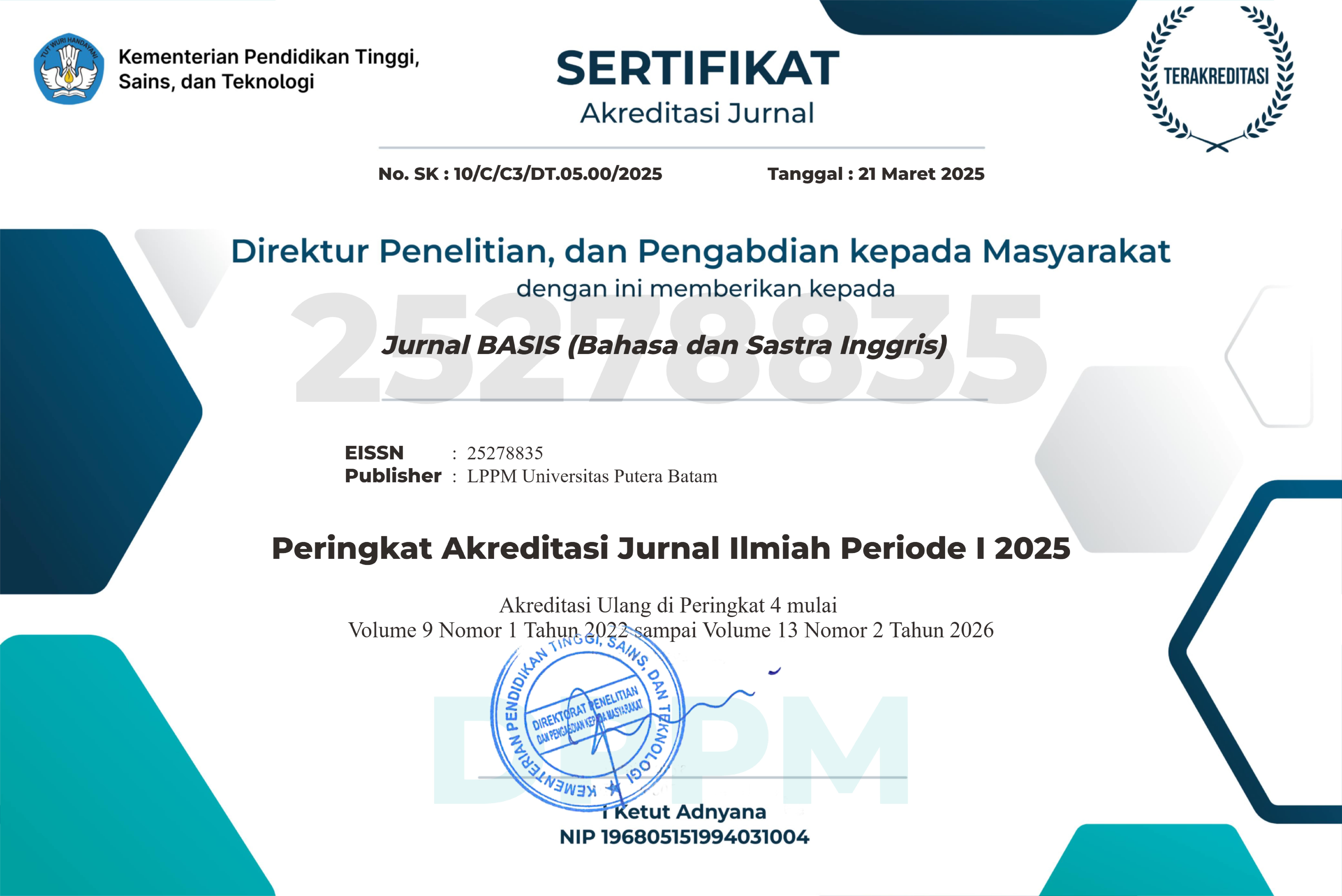THE STUDENTS’ IMPLEMENTATION OF ETIQUETTE IN TABLE MANNERS PROGRAM
DOI:
https://doi.org/10.33884/basisupb.v12i1.9987Kata Kunci:
Implementation ,Etiquette, Table MannersAbstrak
Penelitian ini bertujuan untuk menganalisis penerapan etiket siswa dalam program manner yang mengajarkan aturan-aturan sopan santun dalam konteks makan bersama. Etiket meja merupakan bagian penting dalam kehidupan sosial dan profesional, dan keterampilan ini diharapkan dapat meningkatkan citra diri serta keterampilan interpersonal siswa. Metode yang digunakan dalam penelitian ini adalah dengan memberikan kuesioner dan wawancara terhadap siswa semester 7 yang mengikuti program, menunjukkan bahwa sebagian besar siswa semester 7 dapat menerapkan etiket dengan baik, meskipun terdapat beberapa kesulitan dalam memahami dan mempraktikkan beberapa aturan yang lebih kompleks. Faktor yang mempengaruhi tingkat keberhasilan implementasi etiket mencakup tingkat pemahaman, latar belakang budaya, serta pengaruh dari instruktur. Penelitian ini menyarankan perlunya pendekatan yang lebih terstruktur dan variasi metode pengajaran untuk meningkatkan efektivitas program Table Manner bagi siswa semester 7.
Referensi
De Moura, L., & Bjørner, N. (2009). Satisfiability modulo theories: An appetizer. Lecture Notes in Computer Science (Including Subseries Lecture Notes in Artificial Intelligence and Lecture Notes in Bioinformatics), 5902 LNCS, 23–36. https://doi.org/10.1007/978-3-642-10452-7_3
Djajadiningrat, T., Feijs, L., Hu, J., Rampino, L., & Rodriguez, E. (2012). Design and semantics. DeSForM 2012: Meaning.Matter.Making, April, 18–20. http://nrl.northumbria.ac.uk/9223/%5Cnhttp://desform2012.schoolofdesign.ac.nz/proceedings
Bradshaw, C., Atkinson, S., & Doody, O. (2017). Employing a qualitative description approach in health care research. Global Qualitative Nursing Research, 4, 2333393617742282. https://doi.org/10.1177/2333393617742282
Caelli, K., Ray, L., & Mill, J. (2003). 'Clear as mud': Toward greater clarity in generic qualitative research. International Journal of Qualitative Methods, 2(2), 1–13. https://doi.org/10.1177/160940690300200201
Chafe, R. (2017). An overview of the qualitative descriptive design within nursing research. Journal of Nursing Education and Practice, 7(11), 1–7. https://doi.org/10.5430/jnep.v7n11p1
Colorafi, K. J., & Evans, B. (2016). Qualitative descriptive methods in health science research. HERD: Health Environments Research & Design Journal, 9(4), 16–25. https://doi.org/10.1177/193758671600900404
Creswell, J. W. (2010). Research design: Qualitative, quantitative, and mixed methods approaches (3rd ed.). Sage Publications.
Doyle, L., McCabe, C., & O’Reilly, M. (2016). An overview of the qualitative descriptive design within nursing research. Journal of Nursing Education and Practice, 7(11), 1–7. https://doi.org/10.5430/jnep.v7n11p1
Hallberg, L. R. M. (2013). The characteristics of qualitative descriptive studies. Nursing Research and Practice, 2013, 1–6. https://doi.org/10.1155/2013/578254
Kim, H., Sefcik, J. S., & Bradway, C. (2017). Characteristics of qualitative descriptive studies: A systematic review. Research in Nursing & Health, 40(1), 23–42. https://doi.org/10.1002/nur.21768
Lambert, V. A., & Lambert, C. E. (2012). Qualitative descriptive research: An acceptable design. Pacific Rim International Journal of Nursing Research, 16(4), 255–256.
Lincoln, Y. S., & Guba, E. G. (1985). Naturalistic inquiry. Sage Publications.
Neergaard, M. A., Olesen, F., Andersen, R. S., & Sondergaard, J. (2009). Qualitative description – The poor cousin of health research? BMC Medical Research Methodology, 9, 52. https://doi.org/10.1186/1471-2288-9-52
Ormston, R., Spencer, L., Barnard, M., & Snape, D. (2014). The foundations of qualitative research. In J. Ritchie, J. Lewis, C. McNaughton Nicholls, & R. Ormston (Eds.), Qualitative research practice: A guide for social science students and researchers (2nd ed., pp. 1–25). Sage Publications.
Palinkas, L. A., Horwitz, S. M., Green, C. A., Wisdom, J. P., Duan, N., & Hoagwood, K. (2015). Purposeful sampling for qualitative data collection and analysis in mixed method implementation research. Administration and Policy in Mental Health and Mental Health Services Research, 42(5), 533–544. https://doi.org/10.1007/s10488-013-0528-y
Ritchie, J., Lewis, J., Nicholls, C. M., & Ormston, R. (2014). Qualitative research practice: A guide for social science students and researchers (2nd ed.). Sage Publications.
Sandelowski, M. (2000). Focus on research methods: Whatever happened to qualitative description? Research in Nursing & Health, 23(4), 334–340. https://doi.org/10.1002/1098-240X(200008)23:4<334::AID-NUR9>3.0.CO;2-G
Sandelowski, M. (2010). What's in a name? Qualitative description revisited. Research in Nursing & Health, 33(1), 77–84. https://doi.org/10.1002/nur.20362
Sullivan-Bolyai, S., Bova, C., & Harper, D. (2005). Developing and refining interventions in persons with health disparities: The qualitative descriptive approach. Journal of Nursing Scholarship, 37(1), 77–84. https://doi.org/10.1111/j.1547-5069.2005.00027.x
Sorto, I. M. A., & White, A. (2018). ICOTS10 (2018) Invited Paper Almeda. 10, 1–5.
Stenson, N., & Hornby, A. S. (1996). Oxford Advanced Learner’s Dictionary of Current English. The Modern Language Journal, 80(3), 412. https://doi.org/10.2307/329464
Suryanto, I. W., Astuti, N. M. E. O., & Diarini, I. G. A. A. S. (2020). Efektivitas program pelatihan pengolahan hidangan appetizer and dessert pada siswa SMK Pratama Widhya Mandala. JPPM (Jurnal Pendidikan Dan Pemberdayaan Masyarakat), 7(2), 159–171. https://doi.org/10.21831/jppm.v7i2.32235













 JURNAL BASIS (BAHASA DAN SASTRA INGGRIS)
JURNAL BASIS (BAHASA DAN SASTRA INGGRIS)
